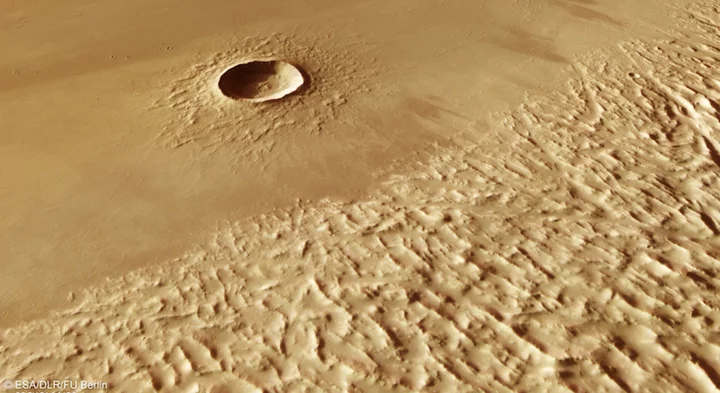A spacecraft orbiting Mars has captured evidence of the Red Planet's dramatic past.
The European Space Agency's (ESA) Mars Express orbiter captured new images of the largest volcano in our solar system, Olympus Mons, focusing on a "rumpled," tortured region of the mountain's outskirts called Lycus Sulci.
Olympus Mons — two and a half times taller than Mount Everest — is encircled by "aureoles" of Martian rock and soil, which is clear evidence of ancient, colossal landslides. What could have triggered such large-scale events? Molten lava once poured down (and formed) the Arizona-sized volcano, which hasn't erupted in some 25 million years. This lava, the ESA explains, melted Martian ice in the bedrock below, destabilizing the volcano's outer rim. Great masses of this rock then broke off.
"This collapse came in the form of huge rockfalls and landslides, which slipped downwards and spread widely across the surrounding plains," the space agency said.
SEE ALSO: NASA spacecraft spots stunning flow of ice on MarsIn the first image below, you can see the rippled portion of Olympus Mons' outskirts captured by the Mars Express Orbiter.
In this satellite image, the inner white box shows the newly viewed areas of the feature Lycus Sulci. Credit: NASA / MGS / MOLA Science TeamThe second image shows an "oblique perspective view of Lycus Sulci," a view generated by the newly imaged areas combined with the agency's digital terrain model, creating a high-resolution image of this unique Martian feature.
The final image reveals two different landslides captured by the ESA’s Mars Express spacecraft, often orbiting over 185 miles above the planet.
The tortured badlands of Lycus Sulci. Credit: ESA / DLR / FU Berlin / CC BY-SA 3.0 IGO The two massive landslide deposits captured by the Mars Express orbiter. Credit: ESA / DLR / FU Berlin / CC BY-SA 3.0 IGOSuch massive landslides can be hundreds of meters, or yards, thick. "However, for this behemoth, which saw multiple colossal and overlapping collapses, they can be up to two kilometres [over 1 mile] thick," the space agency noted.
Want more science and tech news delivered straight to your inbox? Sign up for Mashable's Light Speed newsletter today.
Today, Mars is a much quieter desert. There's no active lava flowing on the surface, but, perhaps a few hundred thousand years ago or less, lava may have oozed up near the surface. What's more, relatively huge quakes still hit Mars from time to time: The welling up of Martian magma may have stressed the ground in places, triggering temblors.
Long ago, when water also ran over the Martian surface, it's possible the planet supported primitive microbial life, the type NASA's car-sized rovers are hunting for in the arid Mars desert.









